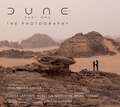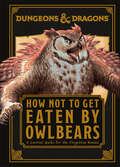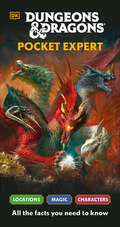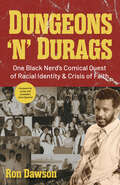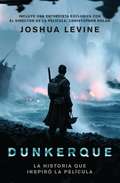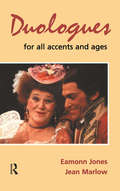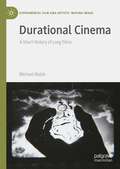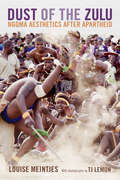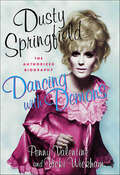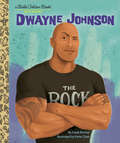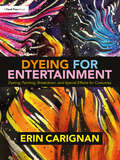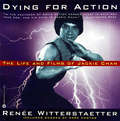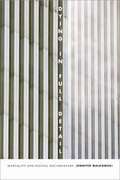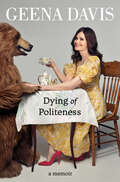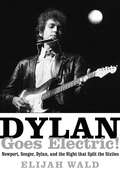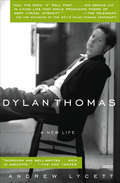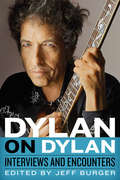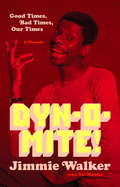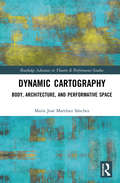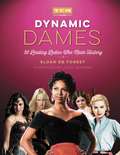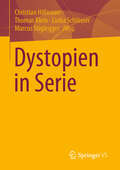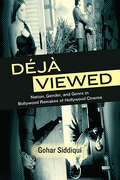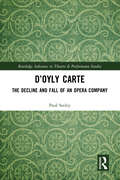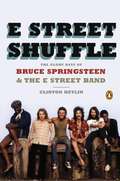- Table View
- List View
Dune Part One: The Photography
by Chiabella JamesExperience the creation of Denis Villeneuve&’s Dune like never before with this startling collection of photography by Chiabella James.From the cliffs of Norway to the deserts of Jordan, unit photographer Chiabella James was on set to capture every moment of Dune, director Denis Villeneuve&’s Oscar-nominated sci-fi epic based on Frank Herbert&’s classic novel. Curated from thousands of stills shot throughout the filming of Dune, this deluxe volume compiles the most compelling photos to form a remarkable visual journey that fully captures the unique spirit of the production. Encompassing the epic vistas witnessed on location shoots, through to candid moments between Villeneuve and key cast members including Timothée Chalamet, Rebecca Ferguson, Oscar Isaac, Josh Brolin, Zendaya, Sharon Duncan-Brewster, and Jason Momoa, this book also features a foreword by executive producer Tanya Lapointe (The Art and Soul of Dune), a preface by Ferguson, and an afterword by Brian Herbert. DAZZLING IMAGES: Curated from thousands of photos shot throughout the filming of Dune, this visually stunning compilation features the most remarkable photos from the set, including the epic vistas of location shoots. BEHIND-THE-SCENES CONTENT: Witness candid moments between director Denis Villeneuve and key cast members, including Timothée Chalamet, Rebecca Ferguson, Oscar Isaac, Josh Brolin, Zendaya, Sharon Duncan-Brewster, and Jason Momoa, plus never-before-seen photos from the set. THE IDEAL COLLECTOR&’S ITEM: Dune Part One: The Photography is the quintessential collectible for fans of director Denis Villeneuve and film enthusiasts everywhere. COMPLETE YOUR DUNE FILM COLLECTION: Dune Part One: The Photography is the perfect companion volume to the gorgeous Insight Editions book The Art and Soul of Dune.
Dungeons & Dragons How Not To Get Eaten by Owlbears
by Anne TooleThe Forgotten Realms are dangerous. Well, that’s an understatement. The Forgotten Realms are a death trap… But they’re also very exciting, packed with amazing sights, and fun to explore. And that’s where this book comes in. An in-world guide written from the point of view of a famous character from D&D’s lore, this book will answer your burning questions via chapters covering deadly fauna, magical mishaps, urban perils, merciless monsters and much more. Whether you want to know which is the best tavern in Baldur’s Gate or have a pressing need for tips on how to escape an ogre’s lair, with this handy, humorous guide at your fingertips, your adventures will end in fame and fortune, rather than somebody else’s stomach. © and ™ 2023 Wizards of the Coast
Dungeons & Dragons Pocket Expert (Pocket Expert)
by Stacy KingBecome an instant expert on all things Dungeons & Dragons with this handy pocket-sized guide! Discover everything you ever needed to know about the world of D&D! What’s the difference between a rogue and a ranger? What exactly are the Forgotten Realms? Can a wizard cast more spells than a sorcerer? How many tentacles does a Mind Flayer have? From mighty dragons to powerful bards, and magical elves to fearsome monsters, this pocket guide is just the beginning of your adventure. Packed with facts, stats, and interesting info about the incredible Dungeons & Dragons universe, the Pocket Expert gives young D&D fans a one-stop source of amazing facts to wow their friends with! © and ™ 2023 Wizards of the Coast
Dungeons 'n' Durags: One Black Nerd's Comical Quest of Racial Identity & Crisis of Faith
by Ron DawsonFunny Stories About White Privilege and Black Identity from a Black Nerd’s PerspectiveAuthor and Ebony Magazine podcaster Ron Dawson lends his wit and comical social commentary to tell the story of how one of the “whitest” and nerdiest of black men finally woke up, found his blackness, and lost all inhibitions at dropping the f-bomb.A coming-of-age story of black identity. In the suburbs of Atlanta, Ron was a black nerd (aka “blerd”) living very comfortably in his white world. He loved his white wife, worked well with his white workmates, and worshiped at a white church. On November 8, 2016, everything changed when Trump became POTUS. Ron began a journey of self-discovery that made him question everything —from faith to friendships.Part social commentary and part fantastical narrative. This book goes where no blerd has gone before. In a psychedelic way, Ron is guided by a guardian “angel” in the guise of Samuel L. Jackson’s character from Pulp Fiction. Sam is there to help Ron, well, be more black. Ron confronts his black “sins” and wrestles with black identity, systemic racism, and what it means to be “black” in America. Uncomfortable conversations. Throughout this book, you’ll learn lessons from a man who deconstructs his faith and confronts personal demons of racial identity. Gain new perspectives through these funny stories that will reshape your current views on black identity.Inside, you’ll find:The funniest social commentary on white privilege and black identityPolitical satire wrapped in funny stories of a man’s journey to confront the systemic racism and Christian hypocrisy around himComical if not uncomfortable conversations about what it means to be black in AmericaIf you liked You'll Never Believe What Happened to Lacey, Things That Make White People Uncomfortable, Uncomfortable Conversations with a Black Man, or I’m Judging You, you’ll love Dungeons ‘n’ Durags.
Dunkerque
by Joshua LevinePronto una gran película de Christopher Nolan.La épica historia de Dunkirk, mayo de 1940: cuando más de 300.000 tropas aliadas atrapadas fueron dramáticamente rescatadas de la destrucción a manos de la Alemania Nazi por una extraordinaria evacuación vía marítima.La historia real de los soldados, marineros, aviadores y civiles implicados en la evacuación durante los nueve días desde el 27 de mayo a 4 de junio de 1940 se ha convertido en leyenda.Ahora el tema de la película del director Christopher Nolan, protagonizada por Kenneth Branagh, Tom Hardy, Cillian Murphy, Mark Rylance y Harry Styles. La historia que Winston Churchill describió como un «milagro» es detallada por el autor best seller Joshua Levine en su contexto completo y avasallador.Incluye nuevas entrevistas con veteranos y supervivientes, este libro va más allá de las escenas para explorar la vida real de esos soldados, bombardeados y ametrallados en las playas durante días, sin comida ni municiones; los civiles cuyas embarcaciones fueron sobrecargadas; los aviadores que arriesgaron sus vidas para comprarle tiempo valioso en tierra a sus compañeros; y aquellos que no lograron escapar.Contada desde las perspectivas terrestre, marítima y aérea, Dunkirk™ por Joshua Levine es una narración dramática de esta gloriosa derrota.
Duologues for All Accents and Ages
by Jean Marlow Eamonn JonesFirst Published in 2003. Routledge is an imprint of Taylor & Francis, an informa company.
Durational Cinema: A Short History of Long Films (Experimental Film and Artists’ Moving Image)
by Michael WalshThis book argues for a durational cinema that is distinct from slow cinema, and outlines the history of its three main waves: the New York avant-garde of the 1960s, the European art cinema in the years after 1968, and the international cinema of gallery spaces as well as film festivals since the 1990s. Figures studied include Andy Warhol, Ken Jacobs, Chantal Akerman, Marguerite Duras, Claude Lanzmann, James Benning, Kevin Jerome Everson, Lav Diaz, and Wang Bing.Durational cinema is predominantly minimal, but has from the beginning also included a more encompassing or encyclopedic kind of filmmaking. Durational cinema is characteristically representational, and converges on certain topics (the Holocaust, deindustrialization, the experience of the working class and other marginalized people), but has no one meaning, signifying differently at different moments and in different hands. Warhol’s durational cinema of subtraction is quite different from Jacobs’s durational cinema of social disgust, while Lav Diaz’ durational sublime is quite different from Kevin Jerome Everson’s unblinking studies of African-American working people.
Dust of the Zulu: Ngoma Aesthetics after Apartheid
by Louise Meintjes Tj LemonIn Dust of the Zulu Louise Meintjes traces the political and aesthetic significance of ngoma, a competitive form of dance and music that emerged out of the legacies of colonialism and apartheid in South Africa. Contextualizing ngoma within South Africa's history of violence, migrant labor, the HIV epidemic, and the world music market, Meintjes follows a community ngoma team and its professional subgroup during the twenty years after apartheid's end. She intricately ties aesthetics to politics, embodiment to the voice, and masculine anger to eloquence and virtuosity, relating the visceral experience of ngoma performances as they embody the expanse of South African history. Meintjes also shows how ngoma helps build community, cultivate responsible manhood, and provide its participants with a means to reconcile South Africa's past with its postapartheid future. Dust of the Zulu includes over one hundred photographs of ngoma performances, the majority taken by award-winning photojournalist TJ Lemon.
Dusty Springfield: The Authorized Biography
by Penny Valentine Vicki WickhamDusty Springfield led a tragic yet inspiring life, battling her way to the top of the charts and into the hearts of music fans world-wide. Her signature voice made songs such as "I Only Want to Be with You," "Son of a Preacher Man," and "You Don't Have to Say You Love Me," international hits. In Dancing with Demons, two of her closest friends, Valentine and Wickham, capture, with vivid memories and personal anecdotes, a Dusty most people never glimpsed in this no-holds-barred yet touching portrait of one of the world's true grand dames of popular music.
Dvorak in Love
by Josef Skvorecky Paul WilsonFictionalized account of Dvorak's utterly requited love affair with America, when he came to live in the US in 1892, the anthem of which is his most famous piece, "From the New World."
Dwayne Johnson: A Little Golden Book Biography (Little Golden Book)
by Frank BerriosHelp your little one dream big with a Little Golden Book biography about superstar Dwayne "The Rock" Johnson! It's the perfect introduction to nonfiction for preschoolers.This Little Golden Book about Dwayne "The Rock" Johnson—wrestling star, movie star, TV star, and all-around nice guy—is an inspiring read-aloud. Young children will learn that even superstars have setbacks: when Dwayne's dream of playing in the NFL didn't come true, he had to find a different path to happiness and success.Look for more Little Golden Book biographies: • Betty White • Carol Burnett • Lucille Ball • Harry Belafonte • Julie Andrews
Dyeing for Entertainment: Dyeing, Painting, Breakdown, and Special Effects for Costumes
by Erin CarignanDyeing for Entertainment encompasses a wide range of methods of theatrical painting and dyeing to create beautiful artistic products for theatre, film, TV, opera, and themed entertainment. Featuring examples from renowned international artisans in the field, this book provides a wealth of information on creating and changing colors, prints, and surface textures of fabric using traditional and nontraditional costume, scenic, fine-art, and metal-smithing techniques. It also includes new, safer materials and methods to minimize exposure to toxic materials and fumes. With more than 250 full-color images, this technical manual is designed to guide and inspire new artists in the collaborative art of painting, dyeing, ageing, and slinging blood and bling on costumes that is an essential part of creating characters for the entertainment industry. Written for undergraduate and graduate students of costume design and technology, professional dyers and breakdown artists, and cosplayers, this book can be used as a reference and springboard to create your own magical processes, custom fabrics, and unforgettable costumes. To access the online materials, including printable swatch sheets, a collection of relevant safety data sheets, and a source guide with links, visit www.routledge.com/9780815352327.
Dying for Action: The Life and Films of Jackie Chan
by Renée WitterstaetterA biography of action film star Jackie Chan.
Dying in Full Detail: Mortality and Digital Documentary
by Jennifer MalkowskiIn Dying in Full Detail Jennifer Malkowski explores digital media's impact on one of documentary film's greatest taboos: the recording of death. Despite technological advances that allow for the easy creation and distribution of death footage, digital media often fail to live up to their promise to reveal the world in greater fidelity. Malkowski analyzes a wide range of death footage, from feature films about the terminally ill (Dying, Silverlake Life, Sick), to surreptitiously recorded suicides (The Bridge), to #BlackLivesMatter YouTube videos and their precursors. Contextualizing these recordings in the long history of attempts to capture the moment of death in American culture, Malkowski shows how digital media are unable to deliver death "in full detail," as its metaphysical truth remains beyond representation. Digital technology's capacity to record death does, however, provide the opportunity to politicize individual deaths through their representation. Exploring the relationships among technology, temporality, and the ethical and aesthetic debates about capturing death on video, Malkowski illuminates the key roles documentary death has played in twenty-first-century visual culture.
Dying of Politeness: A Memoir
by Geena DavisFrom two-time Academy Award winner and screen icon Geena Davis, the surprising tale of her “journey to badassery”—from her epically polite childhood to roles that loaned her the strength to become a powerhouse in Hollywood.At three years old, Geena Davis announced she was going to be in movies. Now, with a slew of iconic roles and awards under her belt, she has surpassed her childhood dream—but the path to finding yourself never did run smoothly. In this simultaneously hilarious and candid memoir, Davis regales us with tales of a career playing everything from an amnesiac assassin to the parent of a rodent, her eccentric childhood, her relationships, and helping lead the way to gender parity in Hollywood—all while learning to be a little more badass, one role at a time. Dying of Politeness is a touching account of one woman’s journey to fight for herself, and ultimately fighting for women all around the globe.
Dylan Goes Electric!: Newport, Seeger, Dylan, and the Night that Split the Sixties
by Elijah WaldTHE INSPIRATION FOR THE MAJOR MOTION PICTURE A COMPLETE UNKNOWN. One of the music world’s pre-eminent critics takes a fresh and much-needed look at the day Dylan “went electric” at the Newport Folk Festival.On the evening of July 25, 1965, Bob Dylan took the stage at Newport Folk Festival, backed by an electric band, and roared into his new rock hit, Like a Rolling Stone. The audience of committed folk purists and political activists who had hailed him as their acoustic prophet reacted with a mix of shock, booing, and scattered cheers. It was the shot heard round the world—Dylan’s declaration of musical independence, the end of the folk revival, and the birth of rock as the voice of a generation—and one of the defining moments in twentieth-century music.In Dylan Goes Electric!, Elijah Wald explores the cultural, political and historical context of this seminal event that embodies the transformative decade that was the sixties. Wald delves deep into the folk revival, the rise of rock, and the tensions between traditional and groundbreaking music to provide new insights into Dylan’s artistic evolution, his special affinity to blues, his complex relationship to the folk establishment and his sometime mentor Pete Seeger, and the ways he reshaped popular music forever. Breaking new ground on a story we think we know, Dylan Goes Electric! is a thoughtful, sharp appraisal of the controversial event at Newport and a nuanced, provocative, analysis of why it matters.“In this tour de force, Elijah Wald complicates the stick-figure myth of generational succession at Newport by doing justice to what he rightly calls Bob Dylan’s ‘declaration of independence’ . . . This is one of the very best accounts I’ve read of musicians fighting for their honor.” — Todd Gitlin, author of The Sixties and Occupy Nation
Dylan Thomas: A New Life
by Andrew LycettThe renowned literary biographer offers a &“thoroughly well-written&” chronicle of the legendary Welsh poet&’s life that is &“rich in anecdote&” (The New Yorker). Dylan Thomas is as legendary for his raucous life as for his literary genius. The author of the immortal poems Death Shall Have No Dominion, Before I Knocked, and Do Not Go Gentle into That Good Night, as well as the short story A Christmas in Wales, and the &“play for voices&” Under Milk Wood, published his first book, 18 Poems, in 1934, when he was only twenty years old. When he died in New York in 1953, at age thirty-nine, the myths took hold: he became the Keats and the Byron of his generation—the romantic poet who died too young, his potential unfulfilled. Making masterful use of original material from archives and personal papers, Andrew Lycett describes the development of the young poet, brings valuable new insights to Thomas&’s poetry, and unearths fascinating details about the poet&’s many affairs and his tempestuous marriage to his passionate Irish wife, Caitlin. The result is a poignant yet stirring portrait of the chaos of Thomas&’s personal life and a welcome re-evaluation of the lyricism and experimentalism of his literary legacy. &“This is the best biography of the poet I have ever read.&” —Robert Nye, The Scotsman
Dylan on Dylan: Interviews and Encounters (Musicians in Their Own Words)
by Jeff BurgerIn a 1969 conversation with Rolling Stone editor Jann Wenner, Dylan proclaims, "I don't give interviews." But in truth, Dylan has given numerous press conferences, spoken at length with print publications large and small and with broadcast media around the world and even answered listeners' questions on call-in radio shows. Dylan can be as evasive and abstruse as he is witty; he can be cranky and sarcastic. But in the right moments, he offers candid, revealing commentary about his groundbreaking music and creative process. Those conversations reveal glimpses into the mind of one of the most important performers and songwriters of the last hundred years. Dylan on Dylan is an authoritative, chronologically arranged anthology of interviews, speeches and press conferences, as well as excerpts from nearly a hundred additional Q&As spanning Dylan's entire career—from 1961 through 2016. The majority have not been previously available in print. The material comes from renowned publications like Rolling Stone and from obscure periodicals like Minnesota Daily, a student newspaper at Dylan's alma mater. Interviewers include some of the top writers of our time, such as Jonathan Lethem, Douglas Brinkley, and Mikal Gilmore, as well as musicians like Pete Seeger and Happy Traum. Introductions put each piece in context and, in many cases, include the interviewer's reminiscences about the encounter.
Dyn-o-mite!: Good Times, Bad Times, Our Times -- A Memoir
by Jimmie Walker Sal MannaJimmie Walker was born in 1947 in the Bronx. At 22, he began performing as a standup comedian and was eventually discovered by the casting director for "Good Times." Walker was the first successful young black sitcom star, and his catchphrase--"Dyn-o-mite!"--remains an indicator of the era. He continues to tour the country doing stand-up and lives in Las Vegas.
Dynamic Cartography: Body, Architecture, and Performative Space (Routledge Advances in Theatre & Performance Studies)
by María José Martínez SánchezDynamic Cartography analyses the works of Rudolf Laban, Lawrence Halprin, Anne Bogart, Adolphe Appia, Cedric Price, Joan Littlewood, and Hélio Oiticica. They are practitioners who have worked on different areas of enquiry from the existing relations between body and space through movement, events, or actions but whose work has never been presented from this perspective or in this context. The work and methodologies set up by these practitioners enable us to develop a practice-based exploration. Some of the experiments in the book – Micro-actions I and II – explore the presence of the body in the space. In Kinetography I and II, Laban’s dance notation system – kinetography – is used to create these dynamic cartographies. Kinetography III proposes the analysis of an urban public space through the transcription of the body movement contained on it. The series Dynamic Cartographies I, II, and III analyses movement in geometrically controlled spaces through the Viewpoints techniques by Anne Bogart. Finally, Wooosh! and Trellick Tales present two projects in which performance is applied in order to analyse and understand urban and architectural space.
Dynamic Dames: 50 Leading Ladies Who Made History (Turner Classic Movies)
by Sloan De ForestCelebrate 50 of the most empowering and unforgettable female characters ever to grace the screen, as well as the artists who brought them to vibrant life!From Scarlett O'Hara to Thelma and Louise to Wonder Woman, strong women have not only lit up the screen, they've inspired and fired our imaginations. Some dynamic women are naughty and some are nice, but all of them buck the narrow confines of their expected gender role -- whether by taking small steps or revolutionary strides.Through engaging profiles and more than 100 photographs, Dynamic Dames looks at fifty of the most inspiring female roles in film from the 1920s to today. The characters are discussed along with the exciting off-screen personalities and achievements of the actresses and, on occasion, female writers and directors, who brought them to life.Among the stars profiled in their most revolutionary roles are Bette Davis, Mae West, Barbara Stanwyck, Josephine Baker, Greta Garbo, Audrey Hepburn, Natalie Wood, Barbra Streisand, Julia Roberts, Meryl Streep, Joan Crawford, Vivien Leigh, Elizabeth Taylor, Dorothy Dandridge, Katharine Hepburn, Pam Grier, Jane Fonda, Gal Gadot, Emma Watson, Zhang Ziyi, Uma Thurman, Jennifer Lawrence, and many more.
Dystopien in Serie
by Marcus Stiglegger Christian Hißnauer Thomas Klein Lioba SchlösserSerielle Dystopien sind omnipräsent; sei es in der Literatur, im Spielfilm, der Fernseh- bzw. Streamingserie oder auch im Videogame. Das Buch verbindet ein wesentliches Erzählverfahren (die Serie) mit gerade kontrovers diskutierten Themen (u.a. Diversity, Covid 19) und dem Genre ihrer medialen Verhandlung. Die Serialität dystopischer Erzählungen ist ein transmediales Phänomen. Der Band geht der Frage nach, wie sich negative Zukunftsvorstellungen, aber auch kontrafaktische Vergangenheitsentwürfe medienspezifisch darstellen, wie sie darüber hinaus im Zuge der Medienkonvergenz größere Erzähluniversen herausbilden. Im Mittelpunkt stehen dabei vor allem Überlegungen, ob sich die serielle Form in besonderer Weise dafür eignet, von dystopischen Gesellschaftsvisionen zu erzählen.
Déjà Viewed: Nation, Gender, and Genre in Bollywood Remakes of Hollywood Cinema (SUNY series, Horizons of Cinema)
by Gohar SiddiquiSituates the remake as one of the primary responses to Bollywood's globalization and corporatization.Focused on post-1990 Bollywood remakes of Hollywood films, Déjà Viewed tells a larger story of the rapidly changing Indian film industry in the wake of globalization and corporatization. It situates the remake as a gendered response to these changes, drawing on approaches from film theory, gender studies, and cultural studies. The book looks at films from a variety of genres and modes, including the Bollywood family film, romantic comedy, noir, and melodrama, and each film's close analysis is accompanied by attention to concerns related to remake theory, such as homage, anxiety of influence, defamiliarization, and pastiche. Seeking to historicize how gender and genres become translated and transformed in the Bollywood remake, the book contributes to transnational understandings of gender and genre as media texts move across various borders—geographic, cinematic, economic, and aesthetic.
D’Oyly Carte: The Decline and Fall of an Opera Company (Routledge Advances in Theatre & Performance Studies)
by Paul SeeleyThis book considers and discusses aspects of the management of the D’Oyly Carte Opera Company in the twentieth century since the death of its founder Richard D’Oyly Carte, and concentrates on key events that contributed to its demise in 1982. In this book, Paul Seeley follows the analytical model that proposes no single factor triggered the collapse, but rather several, both external and internal. In the case of an opera company the external factors may include public taste and market forces, but more significant are the internal factors such as the management decisions taken in response to external factors and how these compare with the original artistic aims, aspirations and business models of the founder. This is a study by someone with close observation of the administration; at the 1982 demise, Seeley was assistant to the company manager, having earlier served on the music staff. The book is a must-read for music historians, theatre historians and arts-management professionals; as an uncompromisingly critical history of the D'Oyly Carte Opera Company it is designed to serve a wider public, not just the Gilbert and Sullivan opera specialist, but anyone keen to debate the desirability of private or public sponsorship of the performing arts.
E Street Shuffle
by Clinton HeylinThe celebrated popular music scholar presents an intimate portrait of The Boss and his legendary band Bruce Springsteen fans know that the band makes the man, which is why millions of people have jammed stadiums and arenas to see The Boss play countless shows with his incredible E Street Band. In this revelatory and unapologetic biography, respected music scholar Clinton Heylin turns a critical eye towards Springsteen's early days, capturing this classic phase of his career and his rise from Asbury Park hood rat to global rock star. Using long-buried archival recordings and bootlegs, Heylin expertly traces Springsteen's creative process as a songwriter and performer and illuminates the roles of the E Street Band members in creating their distinctive sound. Highly nuanced and as fiery as Springsteen himself, E Street Shuffle offers the most revealing portrait yet written on this American icon.
